Recently updated on March 3, 2023 at 06:08 am
Mladá Boleslav - In 1972 the World Automobile Federation (FIA) merged categories B5 and B6 into class B5 for vehicles with a maximum displacement of 3.000 cc. In the Czechoslovak Championship, the displacement limit was changed to 2.000 cc, whereupon the then state-owned company AZNP (Automobilové závody, národní podnik; today the ŠKODA brand) began preparing an open two-seater for circuit and hill climbs. With the exception of the striking aluminum body, where the front and rear can be folded up, the designers mainly used the modified parts of the production model ŠKODA 5 L for the construction of the ŠKODA SPIDER B110. The four-cylinder engine with OHC valve control was a prototype from the ŠKODA 720 and made 150 hp. In the basic version, it was intended for the new ŠKODA models of classic design. In the SPIDER B5, the engine was in front of the rear axle.
Skoda Spider B5 & Spider II
- The ŠKODA SPIDER B5 and ŠKODA SPIDER II prototypes were among the fastest and most exotic vehicles on the racetracks in what was then Czechoslovakia in the second half of the 1970s
- The built-in prototype engine from the Š 720 OHC series developed up to 180 hp
- The ŠKODA SPIDER B5 is one of the highlights in the collection of the ŠKODA Museum
- The ŠKODA SPIDER II was the first vehicle ever to complete the well-known Ecce H*** hill climb in Šternberk in under four minutes
The racing car, of which only one example was produced, was characterized by its compact dimensions with a length of 3.650 millimeters, a width of 1.700 millimeters and a height of 850 millimeters. The body and engine have been continuously optimized. The displacement of the engine from the Š 720 OHC series increased from the original 1,5 to 1,6 to 1,8 liters. In the last season in 1975, an engine with a displacement of 2,0 liters was used, which, depending on the overall ratio, enabled a top speed of up to 220 km / h. Initially, the designers tested the five-speed racing transmission from the Tatra 603 in the racing car, but soon replaced it with a ŠKODA transmission developed in-house.
The steering corresponded to the series variant, only the steering column was adapted. Modified standard brakes provided the necessary deceleration (disc brakes only at the front). The double wishbone axle at the front and the swing axle at the rear were based on the corresponding series components from the ŠKODA 110; coil springs and shock absorbers were designed for a vehicle weight of just 630 kilograms. Dunlop racing tires were mounted on the 13-inch alloy wheels.
Driving behavior leads to the nickname 'Skokan'
The generally unpredictable driving behavior gave the SPIDER B5 the nickname 'Skokan', which translated means something like 'Springer'. Regular driver Jaroslav Bobek came from a famous motorsport dynasty: his older brother Václav has competed successfully in ŠKODA vehicles since the late 1940s, and his son Václav Bobek jun. started in the years 1975 and 1976 in Czechoslovak hill climbs on the SPIDER B5, which then found its way into the factory museum. During this time Jaroslav Bobek switched to the more modern SPIDER II Type 1972 with a two-liter engine after numerous victories on circuits, mountain races at home and abroad and two championship titles (1974 and 733).
In the middle of the 1975 season the ŠKODA SPIDER II at the start. Since it was originally built in accordance with the technical regulations for vehicles up to 2.000 cc in the European sports car championship, it was necessary to further develop the body. For this purpose, the expertise of the aerodynamics experts at the aircraft manufacturer Aero was used, among other things. In contrast to its predecessor, the SPIDER B5, whose floor platform originated from the series and was modified accordingly, the front part of the SPIDER II was based on a self-supporting skeleton. It was spot-welded from thin sheet steel and the adjoining lattice construction carried the powerful motor.
720 series aluminum motor
The ŠKODA aluminum engine from the 720 series had either OHC or DOHC valve control, dry sump lubrication and an output of up to 180 hp. The FT200 transmission, Girling brakes and Koni shock absorbers were imported. The suspension of the 13-inch wheels with double wishbones at the front and multi-link suspension at the rear corresponded to the state of the art of European racing vehicles at the time, the tires came from Goodyear. With a curb weight of 585 kilograms, the SPIDER II reached a top speed of 200 to 240 km / h, depending on the gear ratio, and accelerated from 0 to 100 km / h in just four seconds.
Jaroslav Bobek took part in several races in the 1975 season with this prototype – including the famous Ecce H*** hill climb in Šternberk not far from the city of Olomouc. There he was the first starter ever to achieve a time of less than four minutes. In other races, too, the SPIDER II was at the forefront of the field and achieved several victories. The career of what was to date the fastest ŠKODA car of all time ended with a curious accident in the hill climb in Hlásná Třebáň. The victorious Jaroslav Bobek drove through the finish line and collided with another car which, for unknown reasons, was backing up in the finish area. The drivers were unharmed, but the self-supporting skeleton of the vehicle was so badly damaged that no repairs were made at the time. The ŚKODA SPIDER B5 is now one of the most valuable exhibits in the ŠKODA Museum, while the ŠKODA SPIDER II is currently undergoing extensive repairs.
Of course, that wasn't the end of it. Our tuning magazine has tens of thousands of other tuning reports in stock. Do you want to see them all? Just click HERE and look around. Or are you especially interested in our Tuning classics category? Then the following extract of tuned young and old timers is sure to be just the thing to browse.
ŠKODA SPIDER B5 (1972) and ŠKODA SPIDER II (1975) - prototypes for the racetrack
Photo credit: Škoda
tuningblog.eu - on the subject of cars, motorcycles, bikes / ATV / scooters & Co., and of course our passion, the Tuning, we keep you up to date and report daily on cool vehicles from all over the world. It's best to subscribe to ours Feed and you will be automatically informed as soon as there is a new post.
 tuningblog.eu Your magazine about tuning the car
tuningblog.eu Your magazine about tuning the car




